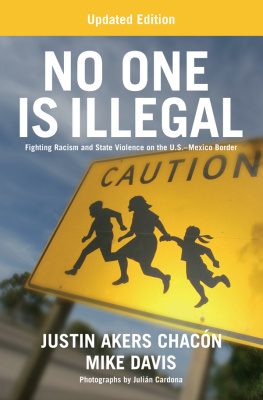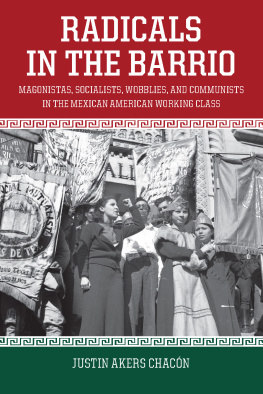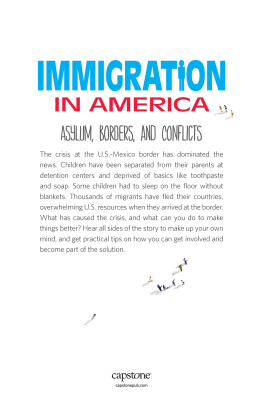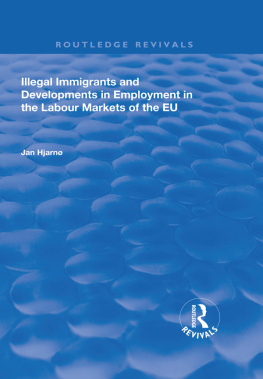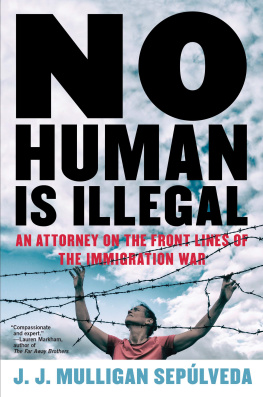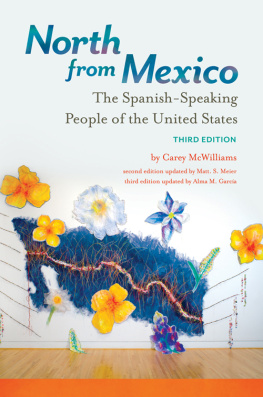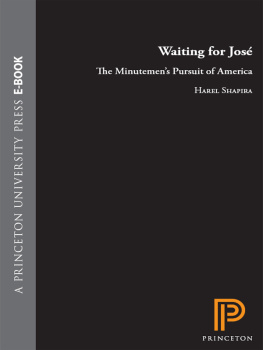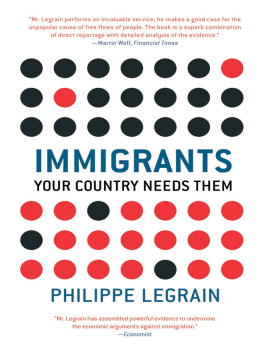NO ONE IS ILLEGAL
NO ONE IS ILLEGAL
Fighting Racism and State Violence on the U.S.Mexico Border
________________
Justin Akers Chacn
Mike Davis
________________
Photographs by Julin Cardona
Updated Edition

2018 by Justin Akers Chacn and Mike Davis
Photographs 2018 Julin Cardona
First published in 2006 by Haymarket Books in Chicago.
This edition published in 2018 by
Haymarket Books
P.O. Box 180165
Chicago, IL 60618
773-583-7884
www.haymarketbooks.org
ISBN: 978-1-60846-590-3
Trade distribution:
In the US, Consortium Book Sales and Distribution, www.cbsd.com
In Canada, Publishers Group Canada, www.pgcbooks.ca
In the UK, Turnaround Publisher Services, www.turnaround-uk.com
All other countries, IPS International,
This book was published with the generous support of Lannan Foundation and Wallace Global Fund.
Cover image of a freeway sign near the U.S.-Mexico border in San Diego, California. Photo Joe Klein/Zuma Press.
Cover design by Amy Balkin.
Library of Congress Cataloging-in-Publication data is available.

Preface to the 2018 Edition
Trump and the Failure of Neoliberal Immigration Reform
When presidential candidate Donald Trump cast aspersions on Mexicans in the United States as criminals, drug dealers, and rapists, it was not just the noxious ranting of a self-entitled bigot. Renewed attention to Trump and his newfound anti-Latino and anti-immigrant posturing illustrates more than just another perversion of an electoral system long corrupted by wealthy opportunists. Rather, Trumps rhetoric was a political calculation to gain traction for an otherwise an incoherent and uninspiring campaign. Latching onto Mexican and immigrant bashing to leverage support from a shrinking yet well-funded and well-organized base of white conservatives was a strategy designed to recharge the fetid Trump brand, which had become little more than a caricature in popular culture. Latino race-baiting and immigrant-bashing has become a ritualized practice on the conservative circuit and a political get-rich-quick scheme for opportunists seeking traction in the polls through inflammatory incitement. In this, Trump is not a departure but rather a continuation of the politics of his predecessors, both Republican and Democrat.
Trumps antics also reveal more than just the bankruptcy of immigration politics in the U.S., in which the racialized dehumanization of Latino migrants and immigrant workers as illegals is normalized in media and political discourse. Rather, it is the latest exhumation of the Brown Scare, a deeply rooted strain of racism directed toward people of Mexican and Central American origin that has been resuscitated and reimagined in the era of what George Bush declared a generational war on terrorism. As part of the current phase of U.S. imperialism in the Middle East, immigration has been reframed as a national security threat, conflating refugees and economic migrants with the peril of terrorist activity.
The political dividends of racial scapegoating and fear-mongering were illustrated by the 2016 presidential victory of Donald Trump, who, in his first hundred days in office, made it the priority of his administration to target Muslim and Mexican peoples. One of the first acts of the Trump administration was to issue an executive order that explicitly restricted the entry of Muslim travelers from Iran, Libya, Somalia, Sudan, Syria, and Yemen to the United States, imposing a three-month ban on those seeking to apply for a visa. It also placed a similar four-month comprehensive ban on refugees, by suspending the already woefully inadequate United States Refugee Admissions Program. The rationale for the targeted exclusions was, according to the order, Each of these countries is a state sponsor of terrorism, has been significantly compromised by terrorist organizations, or contains active conflict zones.
What the order failed to mention is that the U.S. government has already been targeting these predominantly Muslim nations through aerial bombings, proxy war, drone attacks, and other forms of clandestine warfare over the past several years. While claiming that the order was intended to protect citizens from terrorist attacks, including those committed by foreign nationals, it failed to mention that no citizens from these countries have committed any acts of terrorism on U.S. soil. Rather, this is part of a long tradition in the United States of using immigration policy as another type of weapon in the empires arsenal.
In practice, the administrations mounting attack on Muslims is not a departure but rather an intensification of the ideological war on people who have been in the crosshairs of U.S. imperialism over the last two decades. Characterizing Yemeni refugees as potential terrorists legitimizes the U.S. governments ongoing drone assassinations in that country and reinforces support for a bloody invasion and sustained war and bombing campaign against the Yemeni population by the U.S.-allied and armed Saudi Arabian government.
Claiming Syrian and Iraqi refugees are therefore a threat to U.S. national security is the ultimate irony, as millions of Syrians and Iraqis have been displaced as a result of U.S. policies in their countries.
A second front in this attack targets undocumented Mexican and Central American immigrants within the United States. Again, the executive order falsely characterizes this population as a threat, claiming, Aliens who illegally enter the United States without inspection or admission present a significant threat to national security and public safety. Among those who illegally enter are those who seek to harm Americans through acts of terror or criminal conduct. Continued illegal immigration presents a clear and present danger to the interests of the United States. Researchers have long dispelled the notion of the criminal immigrant, including researchers that collect crime data for police departments and the FBI, but that is not the point.
The same executive order rhetorically affirms the continuation of the trajectory of immigration politics and policy from Reagan to Clinton, and from Bush to Obama: increased militarization of border enforcement and the further expansion of the existing six-hundred-mile wall; augmentation of enforcement personnel and their authority; police participation in immigration enforcement; and expansion of the countrys detention and deportation capacities. While Congress must approve the funding for Trumps increased expenditures for the Department of Homeland Security (it approved $65 billion in 2016), the proposals are based on existing policy statutes that enable such increases. Presidents from both parties have made use of this statute to ratchet up enforcement over the last generation.
Another act of the Trump administration has been to implement a series of rule changes known as guidance memos, that are currently being implemented by the DHS under executive authority. The memos give a broader mandate for Immigration and Customs Enforcement (ICE) agents to arrest, detain, and deport undocumented people, as well as authorizing them to act on their own impulses and target people more generally in the course of conducting their duties without restriction or checks. Anyone who cannot prove two-year consistent residence can be put into the expedited removal process, regardless of criminal record.

